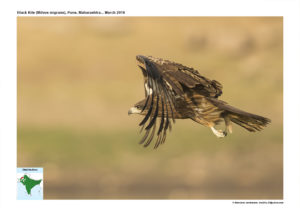Black Kite

Black Kite Milvus migrans
Etymology:
- Milvus : Latin word for Kite
- Migrans: Latin word for migrate derived from migrare to migrate.
Vernacular names: Sind: Siriun, Hindi: Kali Cheel, Ben: Cheel, Kash: Gont, Pun: Chil, Waddi , Santhali: Kurit, Mhari: Genda, Ass: Chiloni, Mugacharani, Guj: Samali, Cheel, Kashmiri cheel, Shialu samali, Desi samali, Mar: Ghar, Thorli ghar, Ori: Matia chila, Ta: Karum parundu, Te: Malla gadda, Mal: Chakki parundu, Kan: Garuda, Sinh: Rajaliya
Distribution in India: They are found all over the country except for higher reaches of Himalayas.
Description: Size of 44–66 cm; wt. of male 630–928 g, female 750–1080 g; wingspan 120–153 cm. It is dark brown with a white crescent shaped patch in the under wing. It has a distinct forked tail. The gape and Cere are yellow and the beak is Black. No distinct sexual dimorphism but Female are larger Race govinda is smaller having more rufous in crown.
Habitat : It is found around cities, towns , villages frequenting the garbage dump and in mountains.
Food Habits: It is a meat eater. It is an opportunistic hunter, relying mainly on scavenging in Garbage dumps and carcass dumps. They can be seen riding the Thermals over these areas to keep looking for food .They are seen in large numbers. They are also known to hunt small rodents and raid nests of other birds like Baya for eggs or chicks.
Breeding Habits: They breed in the winter months (Jan- Feb) so that the chicks are ready to fly out by monsoon. The male and female pair for a breeding season. The male copulates with the female multiple times. The nest is a rough platform of twigs and rags placed in a tree. Nest sites may be reused in subsequent years. The Nest is decorated with shiny / bright material to indicate that it has been taken. The male collects the material for the nest, while the unguarded female can be approached by other males. Hence the paired male will copulate with female every time it returns back to its nest till the female is ready to lay eggs. The female lays 2-3 eggs. The Female does the incubation while male is on guard and feeding duty. The parents will protect their nest with aggressive behaviour and will dive on any intruder repeatedly to drive them away. The incubation is for 30-34 days. The chicks are born with closed eyes and little down feathers (Altricial). They leave the nest in about 60 days from hatching .They are fed by parents till they leave the nest. The juveniles become Sub-adults and are ready to breed in 2 years.
They are attracted to smoke and fires, where they seek escaping prey. This behaviour has led to Australian native beliefs that kites spread fires by picking up burning twigs and dropping them on dry grass. They are one of the Largest found birds of prey across the world with estimated population of 7 Million.